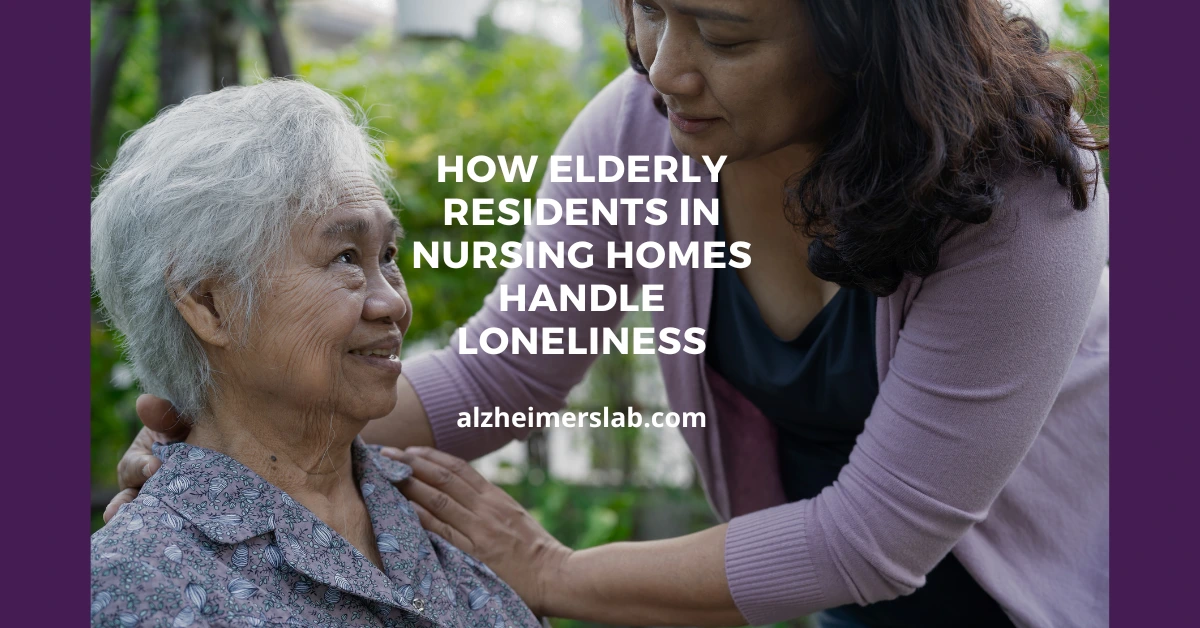How elderly residents in nursing homes handle loneliness
As we age, it’s not uncommon for us to experience feelings of loneliness, and this can be especially true for elderly residents in nursing homes. Many of these individuals have lost loved ones, live far from family members, and may have limited opportunities to socialize. In this blog post, I will talk about how elderly residents in nursing homes handle loneliness and what can be done to support them.
Understanding Loneliness

Loneliness can be described as a feeling of isolation or disconnection from others. It’s important to understand that loneliness is not the same as being alone. Some individuals may enjoy spending time alone and feel fulfilled by solitary activities.
However, loneliness can have negative consequences on mental and physical health. According to a study published in the National Institute on Aging, loneliness among elderly individuals has been linked to a range of negative health outcomes, including depression, anxiety, and even cognitive decline.
The Impact of Loneliness on Elderly Residents in Nursing Homes
Elderly residents in nursing homes are particularly vulnerable to feelings of loneliness. They may feel isolated from friends and family members, and they may have limited opportunities to socialize. Furthermore, nursing homes can be an unfamiliar and often overwhelming environment, which can make it challenging for residents to connect with others.
Loneliness can have a significant impact on the mental health of elderly residents in nursing homes. In one study, researchers found that feelings of loneliness were associated with an increased risk of depression and anxiety. Additionally, loneliness has been linked to physical health problems such as high blood pressure, heart disease, and weakened immune systems.
Coping Strategies for Elderly Residents in Nursing Homes

While loneliness can be challenging for elderly residents in nursing homes, some strategies can be used to cope with these feelings. Some residents may find it helpful to engage in hobbies or activities they enjoy, such as reading, painting, or listening to music. Others may find comfort in spending time outdoors, getting fresh air and sunlight.
Another strategy that can be effective in maintaining social connections with loved ones outside of the nursing home. For example, residents may benefit from regular phone calls, video chats, or even visits from family members or friends. While these interactions may not be as frequent as residents would like, they can still provide a sense of connection and support.
Finally, it’s important to note that many nursing homes offer programs and activities to help residents socialize and connect with others. These can include group outings, exercise classes, and even support groups for individuals dealing with specific challenges or conditions. By participating in these activities, residents can not only combat feelings of loneliness but also improve their physical and mental health.
Challenges to Overcoming Loneliness
While many strategies can be used to overcome loneliness, several challenges can make it difficult for elderly residents in nursing homes to do so. For example, some residents may have physical or cognitive limitations that prevent them from participating in certain activities. Others may struggle with social anxiety or have difficulty forming new relationships.
Additionally, nursing homes themselves can sometimes contribute to feelings of loneliness. For example, staff members may be overworked and unable to provide residents with the level of attention and care they need. Furthermore, nursing homes can sometimes feel institutional and impersonal, which can make it challenging for residents to feel like they belong.
Supporting Elderly Residents in Nursing Homes

Despite the challenges, there are many ways that nursing homes and caregivers can support elderly residents in overcoming loneliness. One important step is to create a warm and welcoming environment that encourages socialization and connection. This can include things like organizing regular events and activities, creating comfortable gathering spaces, and promoting a culture of inclusivity and acceptance.
Caregivers can also take steps to build meaningful relationships with residents by taking time to listen to their concerns and engage in conversations. This can help residents feel valued and heard and can foster a sense of connection and belonging.
In addition, nursing homes need to provide adequate staffing and resources to support residents’ social and emotional well-being. This can include providing training for staff members on how to support residents dealing with loneliness and other mental health concerns, as well as offering resources like counseling services or support groups.
Finally, family members and friends need to stay connected with their loved ones in nursing homes. Even if they are unable to visit in person, regular phone calls or video chats can go a long way in helping residents feel connected and supported.
How can I tell if an elderly resident in a nursing home is feeling lonely?
One of the most common signs of loneliness in an elderly resident is social withdrawal. If they seem disinterested in participating in group activities or interacting with staff and other residents, they may be feeling lonely.
Additionally, if they are spending an excessive amount of time alone or avoiding social situations, this may be a sign that they are struggling with loneliness.
Another sign to look out for is a change in behavior or mood. If an elderly resident is normally social and outgoing but suddenly becomes irritable, depressed, or anxious, this may be a sign that they are feeling lonely. They may also start to express feelings of sadness or hopelessness, indicating that they are struggling to cope with their feelings of isolation.
Physical symptoms can also be a sign of loneliness in elderly residents. For example, if they are experiencing a lack of appetite or weight loss, this may be a result of feeling lonely and disconnected from others. Insomnia or changes in sleep patterns can also be a sign that an elderly resident is struggling with loneliness, as they may be spending their nights alone with their thoughts.
In addition to these signs, it’s important to pay attention to the overall environment and social dynamics within the nursing home. If there is a lack of social activities or opportunities for residents to interact with each other, this may be contributing to feelings of loneliness.
On the other hand, if the staff is friendly and engaged with the residents, and there are plenty of activities and events to participate in, this can help combat feelings of loneliness.
If you suspect that an elderly resident in a nursing home is feeling lonely, there are several steps you can take to help. Encourage them to participate in group activities, and try to visit them frequently to provide companionship and support.
You may also want to speak with the staff or management of the nursing home to discuss ways to improve the social dynamics and opportunities for residents to interact with each other.
How can I encourage an elderly resident to participate in social activities or connect with loved ones outside of the nursing home?

Firstly, it’s important to understand why an elderly resident may be hesitant to participate in social activities. They may be feeling anxious, shy, or simply not interested. It’s important to approach the situation with empathy and understanding, and not to push them too hard or make them feel uncomfortable.
One way to encourage elderly residents to participate in social activities is to find activities that align with their interests and hobbies. For example, if they enjoy gardening, encourage them to participate in a gardening club or help with planting in the nursing home’s garden. If they enjoy music, find a musical performance or sing-along that they can attend.
It’s also important to involve family members in the process. Reach out to family members and encourage them to visit regularly, and involve them in activities that their loved one may enjoy. This can help build a sense of community and connection for the resident.
Another way to encourage participation is to make social activities a part of the daily routine. For example, have a designated time for group activities or meals, and make it clear that residents are encouraged to attend. This can help create a sense of structure and routine, making it easier for residents to participate.
In some cases, it may be helpful to provide additional support to help residents feel more comfortable participating in social activities. For example, if they have difficulty hearing, provide a hearing aid or arrange for an interpreter if necessary. If they have mobility issues, assist with transportation or arrange for activities to be held in inaccessible areas.
It’s important to remember that every resident is different, and what works for one person may not work for another. Be patient, and try different approaches until you find something that works for your loved one. Ultimately, the goal is to help them feel connected, engaged, and fulfilled during their time in the nursing home.
Are there any particular hobbies or activities that are especially effective at combating loneliness among elderly residents?
One such activity is gardening. Gardening provides a sense of purpose and accomplishment, as well as an opportunity to connect with nature. It also provides an opportunity for residents to socialize and work together towards a common goal. Additionally, gardening has been shown to have a calming effect, reducing stress and anxiety.
Another effective activity is art therapy. Art therapy involves using art as a means of self-expression and communication. It can help elderly residents process their emotions and connect with others on a deeper level. Additionally, creating art has been shown to have a positive impact on mental health, reducing symptoms of depression and anxiety.
Music therapy is also an effective way to combat loneliness among elderly residents. Music can evoke strong emotions and memories and can help residents feel more connected to their past and present. Additionally, music has been shown to improve cognitive function and reduce symptoms of depression and anxiety.
Exercise and physical activity are also important for combating loneliness among elderly residents. Exercise releases endorphins, which can improve mood and reduce stress. It also provides an opportunity for residents to socialize and work towards common goals. Activities such as tai chi, yoga, and dance are particularly effective at improving balance and reducing the risk of falls.
Finally, volunteering can also be an effective way to combat loneliness among elderly residents. Volunteering provides a sense of purpose and accomplishment, as well as an opportunity to connect with others in a meaningful way. It also provides an opportunity for residents to give back to the community and make a positive impact on the world around them.
How can nursing homes themselves work to create a more welcoming and inclusive environment for residents dealing with loneliness?
One way to do this is by offering a variety of social activities and programs. This could include things like game nights, movie screenings, art classes, and exercise programs. By providing residents with a variety of options, they can find activities that they enjoy and connect with others who share their interests.
Another important factor is staffing. Nursing homes should prioritize hiring staff members who are compassionate, patient, and empathetic. Staff members should also receive training on how to recognize and address signs of loneliness in residents, as well as how to facilitate social connections.
In addition to these measures, nursing homes can also work to create a physical environment that is conducive to socialization and connection. This could include creating common spaces that are comfortable and inviting, with plenty of seating and natural light.
Nursing homes could also consider incorporating outdoor spaces, such as gardens or patios, where residents can spend time together in a natural setting.
Finally, nursing homes should prioritize communication with residents and their families. This could include regular check-ins with residents to see how they’re feeling and what they need, as well as regular family meetings to discuss the state of the community and any concerns that arise.
Conclusion
Loneliness can be a significant challenge for elderly residents in nursing homes, and caregivers, family members, and society as a whole need to take steps to support these individuals.
By understanding the impact of loneliness, providing resources and support, and creating a welcoming environment that fosters social connections, we can help elderly residents in nursing homes feel more connected, valued, and fulfilled.
If you have experience supporting elderly residents in nursing homes or have additional ideas for ways to combat loneliness, please share them in the comments below.

